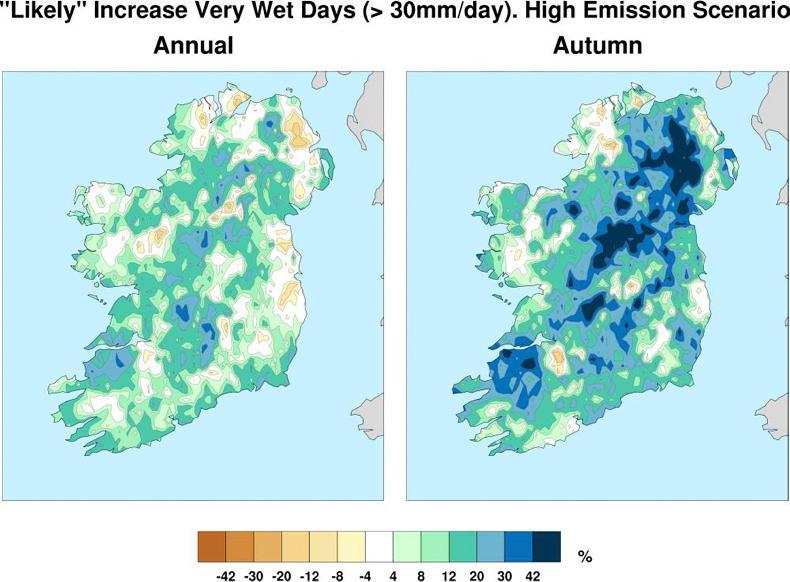Following initial drafting of the agricultural section of the plan in 2015, Minister Creed said that the Government would launch the national strategy covering all sectors of the economy in the coming weeks. "I understand that the draft plan will be published in March for a period of public consultation by my colleague, the Minister for Communications, Climate Action and Environment," he said.
The statutory National Mitigation Plan was provided for in Climate Action and Low Carbon Development Act 2015, and environmentalists say it is long overdue. It will outline how each sector is expected to meet climate change targets set under Ireland's European obligations and the Paris global agreement on climate change.
Emission trends from agriculture and transport are key determinants in meeting targets. However, emissions from both sectors are projected to increase in the period to 2020
Under EU rules, Ireland must cut its so-called non-ETS emissions, which include those from agriculture, by 20% by 2020 compared with 2005. The Environmental Protection Agency (EPA) has said that current trends would only achieve 11%. The EPA commented that "emission trends from agriculture and transport are key determinants in meeting targets. However, emissions from both sectors are projected to increase in the period to 2020". In addition, current European Commission proposals would increase this target to 30% by 2030. These are due to be debated and passed into law this year.
The public consultation documents published by the Department of Agriculture back in 2015 indicated that the mitigation action plan would focus on improving the environmental impact of agriculture through rural development measures and knowledge transfer groups, increasing the level of forest cover and use of wood products and fuel, and enhancing research on agriculture and climate change.
Soil potential
However, the climate change agenda has moved on since those discussions took place, notably with the Paris agreement. The overall draft plan to be published in March is likely to go further if Ireland is to meet its targets.
European proposals include a degree of flexibility for Ireland to offset emissions through the positive effects of storing carbon in soil and trees, and recent research has shown the potential of Irish soils in achieving this.
Separately, Minister Creed reminded the Dáil that a public consultation is open until 27 January on the adaptation plan to be implemented to protect agriculture from the effects of climate change that does occur despite mitigation efforts.
Read more
Full coverage: agriculture and climate change
Following initial drafting of the agricultural section of the plan in 2015, Minister Creed said that the Government would launch the national strategy covering all sectors of the economy in the coming weeks. "I understand that the draft plan will be published in March for a period of public consultation by my colleague, the Minister for Communications, Climate Action and Environment," he said.
The statutory National Mitigation Plan was provided for in Climate Action and Low Carbon Development Act 2015, and environmentalists say it is long overdue. It will outline how each sector is expected to meet climate change targets set under Ireland's European obligations and the Paris global agreement on climate change.
Emission trends from agriculture and transport are key determinants in meeting targets. However, emissions from both sectors are projected to increase in the period to 2020
Under EU rules, Ireland must cut its so-called non-ETS emissions, which include those from agriculture, by 20% by 2020 compared with 2005. The Environmental Protection Agency (EPA) has said that current trends would only achieve 11%. The EPA commented that "emission trends from agriculture and transport are key determinants in meeting targets. However, emissions from both sectors are projected to increase in the period to 2020". In addition, current European Commission proposals would increase this target to 30% by 2030. These are due to be debated and passed into law this year.
The public consultation documents published by the Department of Agriculture back in 2015 indicated that the mitigation action plan would focus on improving the environmental impact of agriculture through rural development measures and knowledge transfer groups, increasing the level of forest cover and use of wood products and fuel, and enhancing research on agriculture and climate change.
Soil potential
However, the climate change agenda has moved on since those discussions took place, notably with the Paris agreement. The overall draft plan to be published in March is likely to go further if Ireland is to meet its targets.
European proposals include a degree of flexibility for Ireland to offset emissions through the positive effects of storing carbon in soil and trees, and recent research has shown the potential of Irish soils in achieving this.
Separately, Minister Creed reminded the Dáil that a public consultation is open until 27 January on the adaptation plan to be implemented to protect agriculture from the effects of climate change that does occur despite mitigation efforts.
Read more
Full coverage: agriculture and climate change






 This is a subscriber-only article
This is a subscriber-only article










SHARING OPTIONS: